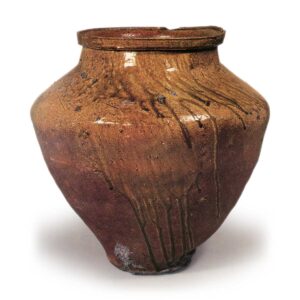
Excavated from the site of an old kiln in Itayama-cho, Handa City, Aichi Prefecture, Japan
14th century
Height 57.3cm, mouth diameter 34.5cm, body diameter 56.8cm, bottom diameter 18.7cm
Tokoname City Ceramic Research Institute
When talking about Tokoname ceramics, which are the most typical Tokoname ceramics in all shapes and sizes, no one would be reluctant to mention this large jar. This large jar has such a style that it is representative of medieval Tokoname. The wide, folded rim band, the sharply curved, almost straight body curve that sharply bends from the strongly stretched shoulder down to the small bottom, are characteristic of the late Kamakura period. Tokoname jars gradually became larger and larger during the Kamakura period, reaching their maximum size from the late Kamakura period to the Nanbokucho period (1392-1333). Not a few of them exceeded 80 cm in height. Along with the development of numerous old kilns, this was also the heyday of Ko-Joname. The dark green ash glaze flowing down the brownish-brown surface of the vessels may be an expression of the strength of this period of prosperity.








